COMC Blog
COMC BLOG
- Messages
- 274
- Real Name
- www.comc.com
As 2018 comes to a close, we want to take a moment to look back at one of our very favorite posts that we have ever shared on the COMC Blog. A long time COMC user graciously submitted this incredible career retrospective of Fred Hutchinson. We’re hoping to be able to share his writing with as many sports fan as possible. This story was originally published on 03/09/2018 and is presented in it’s entirety in this blog as well
—–
(Note from COMC: The following post comes to us from the desk of Stan Opdyke, a lifelong fan of the game of baseball who started collecting cards over 60 years ago. He has an affinity for the Baltimore Orioles, his favorite team in his youngest days. Through his involvement in the Fred Hutchinson Cancer Research Center in Seattle, Mr. Opdyke was inspired to research and write this brilliant look at the cards produced by the life and times of Fred Hutchinson. If you would like to submit your article to us for consideration to be published on our blog, please email us at [email protected].)

Fred Hutchinson
Fred Hutchinson, at the age of 18, began his professional baseball career in 1938 as a pitcher for his hometown Seattle Rainiers of the Pacific Coast League. Baseball cards were relatively scarce items at the time, at least in comparison to what they would become after World War ll, so unsurprisingly no baseball card of Hutch was produced in his first professional season.
Hutch was sensational for the Rainiers in 1938. Pitching most of the season as an 18 year old, Hutch compiled a 25-7 won/loss record and a 2.48 ERA. On his 19th birthday on August 12, 1938, he pitched before a standing room crowd at Seattle’s Sick’s Stadium in search of his 19th victory. Hutch got the win in a game that stands with the Edgar Martinez double that defeated the Yankees in the 1995 post season as one of the most iconic baseball games ever played in Seattle.
Hutch’s superb season drew the attention of major league teams and one of the two major producers of baseball cards in the 1930’s. On December 12, 1938, the Seattle Rainiers traded Fred Hutchinson to the Detroit Tigers for four players and $50,000 Depression era dollars. The huge outlay of cash undoubtedly influenced the Goudey gum company to include Hutch in its 1939 Premium set. The other major baseball card manufacturer of the era, Play Ball, did not issue a card of Hutch in 1939.

1939 Fred Hutchinson Goudey Premium
The 1939 Goudey Premiums are listed in the 2013 Standard Catalogue of Vintage Baseball Cards in two distinct series, R303-A and R303-B. The R303-A cards are slightly smaller but otherwise identical to the R303-B cards. Both series of 1939 Goudey Premiums are unnumbered. Hutch appears in the 303-A series. The 1939 Goudey Premiums are baseball cards in that they were issued by a gum company and depict images of baseball players. However, in other ways they are not like baseball cards at all. The smaller sized 303-A cards still measure a very large 4 inches x 6 3/16 inches, far too large to fit in anyone’s shirt pocket. The Goudey Premiums also differ from typical baseball cards because they are printed on paper stock that is about the thickness of a newspaper page. The 1939 Goudey Premiums have the look and feel of a small poster.
The photograph Goudey selected to use of Hutch is a portrait of a teenager sporting a warm grin. It is a rare photo of a smiling Fred Hutchinson. When he grew older, Hutch was given the nicknames “The Bear” and “Old Stoneface,” quite a contrast to the photo on his 1939 Goudey Premium card.
Hutch struggled in 1939. His trouble began in Spring Training when he lost the ability to throw strikes. His lack of control would have undoubtedly cost him a major league roster spot had the Tigers not invested so much money in him. However, because of the huge cash outlay, Hutch began the 1939 season in the major leagues.
Hutch made his major league debut in one of the most significant games in baseball history. The New York Yankees played against the Tigers in Detroit on May 2, 1939, and for the first time since May 31, 1925, the name of the legendary Lou Gehrig did not appear in a regular season box score. The Yankees scored early and often without Gehrig in the line-up. With the Tigers trailing 13-0, Hutch was brought into the game by Tiger manager Del Baker. Nothing went right for Hutch. Pitching just two-thirds of an inning, he surrendered four hits, five walks and eight earned runs.
Hutch was sent to the minor league Buffalo Bisons of the International League after his disastrous major league debut. His traditional pitching numbers (won/loss and ERA) were better in Buffalo than in Detroit, but in both the major and minor leagues in 1939, his performance significantly lagged the excellent season he had for Seattle in the Pacific Coast League in 1938.

1940 Team Issued Fred Hutchinson Buffalo Bisons card
Hutch’s demotion to the minor leagues led to his second appearance on a baseball card. In 1940 the Buffalo Bisons issued a team set of baseball cards. The 1940 Bisons cards are printed on thicker paper and are much smaller then the 1939 Goudey Premium cards. The unnumbered 1940 Bisons Fred Hutchinson card shows him winding up as if he is about to deliver a pitch. The photograph was obviously staged because the picture was taken on the grass in front of a dugout rather than on a pitcher’s mound.
Hutch pitched for both Buffalo and Detroit in 1940. Detroit won the American League pennant in 1940 and Hutch was included on the Tigers World Series roster. He pitched one World Series inning against a team he would one day manage, the Cincinnati Reds. He allowed one walk, one hit and one earned run.
In 1941 Hutch, pitching for the Buffalo Bisons, turned in a performance reminiscent of his sensational 1938 season in the Pacific Coast League. He won 26 games for Buffalo in 1941 and in 284 innings he turned in an excellent 2.44 ERA. With such a stellar season behind him, Hutch seemed destined to earn a spot on the Tigers major league roster in 1942. World War II however intervened.
Hutch enlisted in the Navy shortly before the Japanese attack on Pearl Harbor. He served in the Navy’s physical education program. Hutch pitched for Navy teams in Norfolk, VA, Seattle, WA, and Hawaii, so during the war he was able to keep his baseball skills sharp.
The baseball players who served in the military in World War II returned en masse to organized baseball in 1946. Hutch was part of the 1946 waive of ex-servicemen returning to professional baseball. He spent the entire year in 1946 with the Detroit Tigers. It was the first time he spent a full season in the major leagues.

1991 Reprint of 1947 Tip Top Bread Fred Hutchinson Card
In 1947 Hutch appeared for the first time on a post war baseball card. The Tip Top Baking Company issued several regional baseball card sets in 1947 to promote the sale of Tip Top Bread. The unnumbered cards feature black and white pictures with the player’s name, position, team and league affiliation printed underneath the photo. Hutch’s Tip Top Bread card features a close up portrait of him wearing a Detroit Tigers cap.
In 1948 Hutch did not appear on a baseball card. In 1949 two gum manufacturers, Bowman and Leaf, produced baseball cards of Hutch. Fred Hutchinson’s 1949 Leaf card is his highest priced card. The 1949 Leaf set is extremely difficult to complete. About half the cards in the set are short printed and Hutch’s card is among the short printed cards. His 1949 Leaf card in excellent condition is worth $900.00. By way of comparison two other Hutch cards that are also difficult to find, his 1939 Goudey Premium card and his 1947 Tip Top Bread card, have much lower prices. His Goudey Premium card in excellent condition lists at $75.00 and his 1947 Tip Top Bread card in excellent condition lists at $150.00. (All prices are from the 2013 Standard Catalogue of Vintage Baseball Cards.)


In 1950, Bowman was the only gum company to produce baseball cards. Hutch is included in the 1950 Bowman set. His 1950 Bowman card is derived from a painting that was transformed into a baseball card. The painting depicts Hutch at the very end of his follow through after delivery of a pitch. Bowman got good mileage out of the painting because they used again in 1951. That same year, Hutch was named to the American League All Star team. He pitched three innings in the 1951 mid-summer classic.


In 1952 Hutch made his first appearance on a Topps card. Topps produced its first baseball card set a year earlier, but in its initial set the company did not issue a card of Fred Hutchinson. Topps made up for its 1951 omission by producing a magnificent card of Hutch in the 1952 set. Bowman again used a painting to create the front of its baseball cards. The artist hired to paint Fred Hutchinson must have noticed the look on Hutch’s face after he had surrendered a long home run.


The Tigers had a miserable year in 1952, almost as miserable as the look on Hutch’s face on his 1952 Bowman card. On July 5th, with the club in last place, Tiger manager Red Rolfe was fired and Hutch was hired to replace him. Hutch remained on the Tigers active playing roster after he took over as manager. He continued in his dual role as a player and a manager in 1953.
Both Topps and Bowman included a card of Hutch in their 1953 sets. Topps took a page from Bowman by using a painting as the template for the front of its 1953 cards. Bowman emulated Topps by issuing a larger baseball card in 1953 than it had produced from 1948 to 1952. (Bowman did not issue a card of Hutch in 1948). The 1953 Bowman set is considered by most collectors as one of the best baseball card sets ever produced. Hutch’s 1953 Bowman card is representative of the picture quality that exists throughout the set.


Hutch retired as an active player after the 1953 season. He managed the Tigers for one year after retiring as a player. Neither Topps nor Bowman included managers in their 1954 sets, so 1954 marked the first time since 1948 that Fred Hutchinson did not appear on a baseball card.
After the 1954 season ended Hutch informed the Tigers he wanted a two year contract. The Tigers refused to offer more than one year. The impasse led to Hutch’s departure from Detroit when he refused to sign the one year contact he was offered.
Hutch was out of a job, but he was not out of baseball. In 1955 he returned to his hometown to manage the Seattle Rainiers to a Pacific Coast League pennant. A year before Hutch”s arrival, the Rainiers began issuing baseball cards to fans who purchased popcorn at the team’s home games. Seattle minor league teams issued popcorn cards every year from 1954 through 1968. It is hardly surprising that Hutch, the popular hometown manager, was included in the popcorn cards the team produced in 1955.
In 1956 Hutch returned to the major leagues to manage the St Louis Cardinals. Topps was the only gum company that manufactured baseball cards during the three years Hutch managed the Cardinals.
Topps did not issue a card of Hutch while he managed in St. Louis. Topps included few cards of managers in the sets it produced from 1956 to 1958. Brooklyn’s Walt Alston and Philadelphia’s Mayo Smith were the only managers Topps included in its 1956 set. No managers were included in the 1957 set. In 1958 Topps issued only two cards of managers, a card of Reds manager Birdie Tebbetts with two of his players, Frank Robinson and Ed Bailey, and a card on which managers Casey Stengel and Fred Haney appeared together.

1960 through 1964 Topps Fred Hutchinson Cards
Hutch enjoyed some success with the Cardinals. In 1957, St. Louis finished in second place, fueling expectations that the team would contend for the pennant in 1958. However in 1958 the Cardinals played poorly, and as a consequence, Hutch was fired shortly before the 1958 season ended.
In 1959 Hutch returned to Seattle to once again manage the Rainiers. His second stint with the club lasted only three months. He was in town long enough though to appear in the 1959 edition of Seattle Rainiers popcorn cards.
In the middle of the 1959 season, Cincinnati Reds manager Mayo Smith was fired. Hutch was chosen to replace him. Hutch managed the Cincinnati Reds to a 1961 World Series appearance. As was customary, he served as the National League All Star manager the following year. As a result of managing in the 1962 All Star game, Hutch became one of about a dozen men in baseball history (Hank Bauer, Yogi Berra and Alvin Dark are a few of the others) to manage and play in a World Series and manage and play in an All Star game.
Hutch remained the manager of the Reds until deteriorating health caused him to take a leave of absence in 1964. Hutch appeared in each baseball card set Topps produced from 1960 through 1964.
In late December of 1963 Hutch was diagnosed with cancer. He died of the disease eleven months after he was diagnosed. Between diagnosis and death, Hutch managed the Cincinnati Reds for most of the 1964 season. The determination and courage Hutch displayed during his last baseball season is told by Bruce Markusen in his excellent Hardball Times article, available online, “The Final Year of Fred Hutchinson’s Life.”
Hutch resigned as the manager of the Reds in a letter he sent to team owner Bill DeWitt dated October 11, 1964. Exactly one month later he died in Bradenton, Florida.
Continue reading...
—–
(Note from COMC: The following post comes to us from the desk of Stan Opdyke, a lifelong fan of the game of baseball who started collecting cards over 60 years ago. He has an affinity for the Baltimore Orioles, his favorite team in his youngest days. Through his involvement in the Fred Hutchinson Cancer Research Center in Seattle, Mr. Opdyke was inspired to research and write this brilliant look at the cards produced by the life and times of Fred Hutchinson. If you would like to submit your article to us for consideration to be published on our blog, please email us at [email protected].)
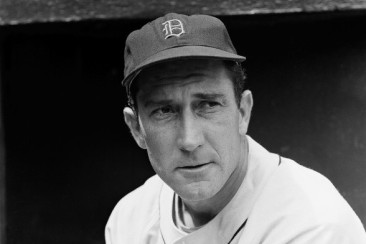
Fred Hutchinson
Fred Hutchinson, at the age of 18, began his professional baseball career in 1938 as a pitcher for his hometown Seattle Rainiers of the Pacific Coast League. Baseball cards were relatively scarce items at the time, at least in comparison to what they would become after World War ll, so unsurprisingly no baseball card of Hutch was produced in his first professional season.
Hutch was sensational for the Rainiers in 1938. Pitching most of the season as an 18 year old, Hutch compiled a 25-7 won/loss record and a 2.48 ERA. On his 19th birthday on August 12, 1938, he pitched before a standing room crowd at Seattle’s Sick’s Stadium in search of his 19th victory. Hutch got the win in a game that stands with the Edgar Martinez double that defeated the Yankees in the 1995 post season as one of the most iconic baseball games ever played in Seattle.
Hutch’s superb season drew the attention of major league teams and one of the two major producers of baseball cards in the 1930’s. On December 12, 1938, the Seattle Rainiers traded Fred Hutchinson to the Detroit Tigers for four players and $50,000 Depression era dollars. The huge outlay of cash undoubtedly influenced the Goudey gum company to include Hutch in its 1939 Premium set. The other major baseball card manufacturer of the era, Play Ball, did not issue a card of Hutch in 1939.
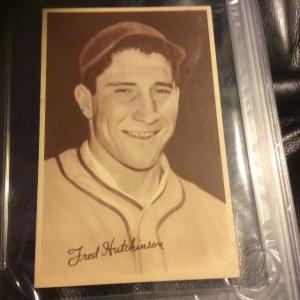
1939 Fred Hutchinson Goudey Premium
The 1939 Goudey Premiums are listed in the 2013 Standard Catalogue of Vintage Baseball Cards in two distinct series, R303-A and R303-B. The R303-A cards are slightly smaller but otherwise identical to the R303-B cards. Both series of 1939 Goudey Premiums are unnumbered. Hutch appears in the 303-A series. The 1939 Goudey Premiums are baseball cards in that they were issued by a gum company and depict images of baseball players. However, in other ways they are not like baseball cards at all. The smaller sized 303-A cards still measure a very large 4 inches x 6 3/16 inches, far too large to fit in anyone’s shirt pocket. The Goudey Premiums also differ from typical baseball cards because they are printed on paper stock that is about the thickness of a newspaper page. The 1939 Goudey Premiums have the look and feel of a small poster.
The photograph Goudey selected to use of Hutch is a portrait of a teenager sporting a warm grin. It is a rare photo of a smiling Fred Hutchinson. When he grew older, Hutch was given the nicknames “The Bear” and “Old Stoneface,” quite a contrast to the photo on his 1939 Goudey Premium card.
Hutch struggled in 1939. His trouble began in Spring Training when he lost the ability to throw strikes. His lack of control would have undoubtedly cost him a major league roster spot had the Tigers not invested so much money in him. However, because of the huge cash outlay, Hutch began the 1939 season in the major leagues.
Hutch made his major league debut in one of the most significant games in baseball history. The New York Yankees played against the Tigers in Detroit on May 2, 1939, and for the first time since May 31, 1925, the name of the legendary Lou Gehrig did not appear in a regular season box score. The Yankees scored early and often without Gehrig in the line-up. With the Tigers trailing 13-0, Hutch was brought into the game by Tiger manager Del Baker. Nothing went right for Hutch. Pitching just two-thirds of an inning, he surrendered four hits, five walks and eight earned runs.
Hutch was sent to the minor league Buffalo Bisons of the International League after his disastrous major league debut. His traditional pitching numbers (won/loss and ERA) were better in Buffalo than in Detroit, but in both the major and minor leagues in 1939, his performance significantly lagged the excellent season he had for Seattle in the Pacific Coast League in 1938.
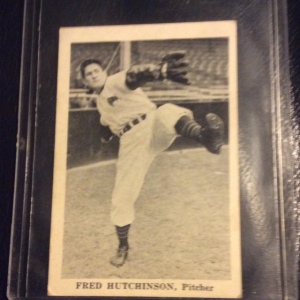
1940 Team Issued Fred Hutchinson Buffalo Bisons card
Hutch’s demotion to the minor leagues led to his second appearance on a baseball card. In 1940 the Buffalo Bisons issued a team set of baseball cards. The 1940 Bisons cards are printed on thicker paper and are much smaller then the 1939 Goudey Premium cards. The unnumbered 1940 Bisons Fred Hutchinson card shows him winding up as if he is about to deliver a pitch. The photograph was obviously staged because the picture was taken on the grass in front of a dugout rather than on a pitcher’s mound.
Hutch pitched for both Buffalo and Detroit in 1940. Detroit won the American League pennant in 1940 and Hutch was included on the Tigers World Series roster. He pitched one World Series inning against a team he would one day manage, the Cincinnati Reds. He allowed one walk, one hit and one earned run.
In 1941 Hutch, pitching for the Buffalo Bisons, turned in a performance reminiscent of his sensational 1938 season in the Pacific Coast League. He won 26 games for Buffalo in 1941 and in 284 innings he turned in an excellent 2.44 ERA. With such a stellar season behind him, Hutch seemed destined to earn a spot on the Tigers major league roster in 1942. World War II however intervened.
Hutch enlisted in the Navy shortly before the Japanese attack on Pearl Harbor. He served in the Navy’s physical education program. Hutch pitched for Navy teams in Norfolk, VA, Seattle, WA, and Hawaii, so during the war he was able to keep his baseball skills sharp.
The baseball players who served in the military in World War II returned en masse to organized baseball in 1946. Hutch was part of the 1946 waive of ex-servicemen returning to professional baseball. He spent the entire year in 1946 with the Detroit Tigers. It was the first time he spent a full season in the major leagues.
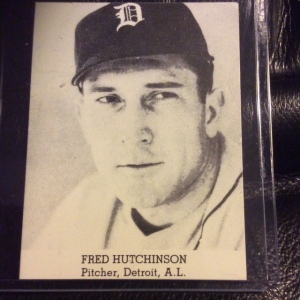
1991 Reprint of 1947 Tip Top Bread Fred Hutchinson Card
In 1947 Hutch appeared for the first time on a post war baseball card. The Tip Top Baking Company issued several regional baseball card sets in 1947 to promote the sale of Tip Top Bread. The unnumbered cards feature black and white pictures with the player’s name, position, team and league affiliation printed underneath the photo. Hutch’s Tip Top Bread card features a close up portrait of him wearing a Detroit Tigers cap.
In 1948 Hutch did not appear on a baseball card. In 1949 two gum manufacturers, Bowman and Leaf, produced baseball cards of Hutch. Fred Hutchinson’s 1949 Leaf card is his highest priced card. The 1949 Leaf set is extremely difficult to complete. About half the cards in the set are short printed and Hutch’s card is among the short printed cards. His 1949 Leaf card in excellent condition is worth $900.00. By way of comparison two other Hutch cards that are also difficult to find, his 1939 Goudey Premium card and his 1947 Tip Top Bread card, have much lower prices. His Goudey Premium card in excellent condition lists at $75.00 and his 1947 Tip Top Bread card in excellent condition lists at $150.00. (All prices are from the 2013 Standard Catalogue of Vintage Baseball Cards.)


In 1950, Bowman was the only gum company to produce baseball cards. Hutch is included in the 1950 Bowman set. His 1950 Bowman card is derived from a painting that was transformed into a baseball card. The painting depicts Hutch at the very end of his follow through after delivery of a pitch. Bowman got good mileage out of the painting because they used again in 1951. That same year, Hutch was named to the American League All Star team. He pitched three innings in the 1951 mid-summer classic.


In 1952 Hutch made his first appearance on a Topps card. Topps produced its first baseball card set a year earlier, but in its initial set the company did not issue a card of Fred Hutchinson. Topps made up for its 1951 omission by producing a magnificent card of Hutch in the 1952 set. Bowman again used a painting to create the front of its baseball cards. The artist hired to paint Fred Hutchinson must have noticed the look on Hutch’s face after he had surrendered a long home run.
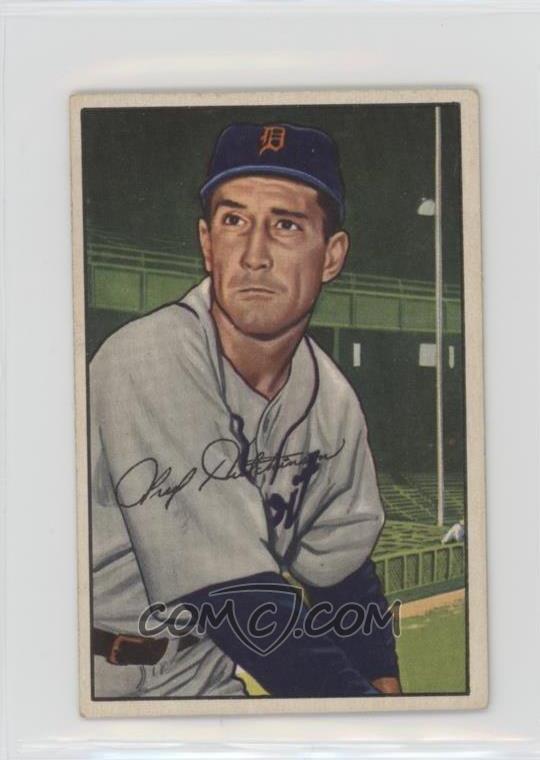

The Tigers had a miserable year in 1952, almost as miserable as the look on Hutch’s face on his 1952 Bowman card. On July 5th, with the club in last place, Tiger manager Red Rolfe was fired and Hutch was hired to replace him. Hutch remained on the Tigers active playing roster after he took over as manager. He continued in his dual role as a player and a manager in 1953.
Both Topps and Bowman included a card of Hutch in their 1953 sets. Topps took a page from Bowman by using a painting as the template for the front of its 1953 cards. Bowman emulated Topps by issuing a larger baseball card in 1953 than it had produced from 1948 to 1952. (Bowman did not issue a card of Hutch in 1948). The 1953 Bowman set is considered by most collectors as one of the best baseball card sets ever produced. Hutch’s 1953 Bowman card is representative of the picture quality that exists throughout the set.


Hutch retired as an active player after the 1953 season. He managed the Tigers for one year after retiring as a player. Neither Topps nor Bowman included managers in their 1954 sets, so 1954 marked the first time since 1948 that Fred Hutchinson did not appear on a baseball card.
After the 1954 season ended Hutch informed the Tigers he wanted a two year contract. The Tigers refused to offer more than one year. The impasse led to Hutch’s departure from Detroit when he refused to sign the one year contact he was offered.
Hutch was out of a job, but he was not out of baseball. In 1955 he returned to his hometown to manage the Seattle Rainiers to a Pacific Coast League pennant. A year before Hutch”s arrival, the Rainiers began issuing baseball cards to fans who purchased popcorn at the team’s home games. Seattle minor league teams issued popcorn cards every year from 1954 through 1968. It is hardly surprising that Hutch, the popular hometown manager, was included in the popcorn cards the team produced in 1955.
In 1956 Hutch returned to the major leagues to manage the St Louis Cardinals. Topps was the only gum company that manufactured baseball cards during the three years Hutch managed the Cardinals.
Topps did not issue a card of Hutch while he managed in St. Louis. Topps included few cards of managers in the sets it produced from 1956 to 1958. Brooklyn’s Walt Alston and Philadelphia’s Mayo Smith were the only managers Topps included in its 1956 set. No managers were included in the 1957 set. In 1958 Topps issued only two cards of managers, a card of Reds manager Birdie Tebbetts with two of his players, Frank Robinson and Ed Bailey, and a card on which managers Casey Stengel and Fred Haney appeared together.
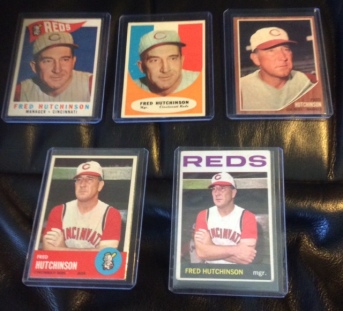
1960 through 1964 Topps Fred Hutchinson Cards
Hutch enjoyed some success with the Cardinals. In 1957, St. Louis finished in second place, fueling expectations that the team would contend for the pennant in 1958. However in 1958 the Cardinals played poorly, and as a consequence, Hutch was fired shortly before the 1958 season ended.
In 1959 Hutch returned to Seattle to once again manage the Rainiers. His second stint with the club lasted only three months. He was in town long enough though to appear in the 1959 edition of Seattle Rainiers popcorn cards.
In the middle of the 1959 season, Cincinnati Reds manager Mayo Smith was fired. Hutch was chosen to replace him. Hutch managed the Cincinnati Reds to a 1961 World Series appearance. As was customary, he served as the National League All Star manager the following year. As a result of managing in the 1962 All Star game, Hutch became one of about a dozen men in baseball history (Hank Bauer, Yogi Berra and Alvin Dark are a few of the others) to manage and play in a World Series and manage and play in an All Star game.
Hutch remained the manager of the Reds until deteriorating health caused him to take a leave of absence in 1964. Hutch appeared in each baseball card set Topps produced from 1960 through 1964.
In late December of 1963 Hutch was diagnosed with cancer. He died of the disease eleven months after he was diagnosed. Between diagnosis and death, Hutch managed the Cincinnati Reds for most of the 1964 season. The determination and courage Hutch displayed during his last baseball season is told by Bruce Markusen in his excellent Hardball Times article, available online, “The Final Year of Fred Hutchinson’s Life.”
Hutch resigned as the manager of the Reds in a letter he sent to team owner Bill DeWitt dated October 11, 1964. Exactly one month later he died in Bradenton, Florida.
Continue reading...

